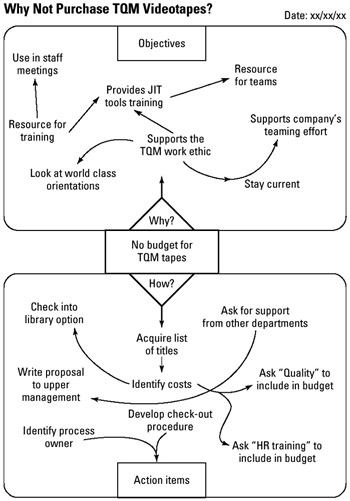Tool 216: WhyHow Charting
Tool 216: Why/How Charting
| AKA | N/A |
| Classification | Planning/Presenting (PP) |
Tool description
The why/how charting is a sorting tool that clusters ideas regarding why particular actions would be supportive of company objectives. Action items necessary to reach objectives were derived by asking how they could be accomplished. The information gained is used to determine what next steps need to be taken.
Typical application
-
To reach a common understanding of the objectives and action items necessary in a problem-solving effort.
-
To explore different alternatives in an action-planning process.
Problem-solving phase
| → | Select and define problem or opportunity |
| → | Identify and analyze causes or potential change |
| → | Develop and plan possible solutions or change |
| Implement and evaluate solution or change | |
| Measure and report solution or change results | |
| Recognize and reward team efforts |
Typically used by
| Research/statistics | |
| 1 | Creativity/innovation |
| Engineering | |
| Project management | |
| Manufacturing | |
| Marketing/sales | |
| Administration/documentation | |
| 2 | Servicing/support |
| Customer/quality metrics | |
| 3 | Change management |
before
-
Five Whys
-
Brainstorming
-
Mind Flow
-
6-3-5 Method
-
Buzz Group
after
-
Actions Plan
-
Consensus Decision Making
-
Cost-Benefit Analysis
-
Information Needs Analysis
-
Presentation
Notes and key points
-
Optional: Draw lines between objectives or action items to show linkages or interrelationships.
-
Or, assign numbers to show sequence or priorities of objectives or action items.
Step-by-step procedure
-
STEP 1 The team facilitator reviews the why/how charting process with the team.
-
STEP 2 Next, the team agrees on a problem or activity to be charted. See example Why Not Purchase TQM Video Tapes?
-
STEP 3 The facilitator places the problem in the center of a whiteboard and asks the participants to respond to why this problem should be addressed and to discover why certain actions will enable the team to reach the implied objectives.
-
STEP 4 Next, participants are asked how these actions can be taken. Alternative actions that also have the potential of solving this problem are listed on the whiteboard.
-
STEP 5 The team visually sorts the information and some linkages; the interrelationships are pointed out to the facilitator, who draws some arrows of directionality.
-
STEP 6 Finally, the chart is checked and dated. This document is checked to provide input into the action-planning process.
Example of tool application

EAN: 2147483647
Pages: 326